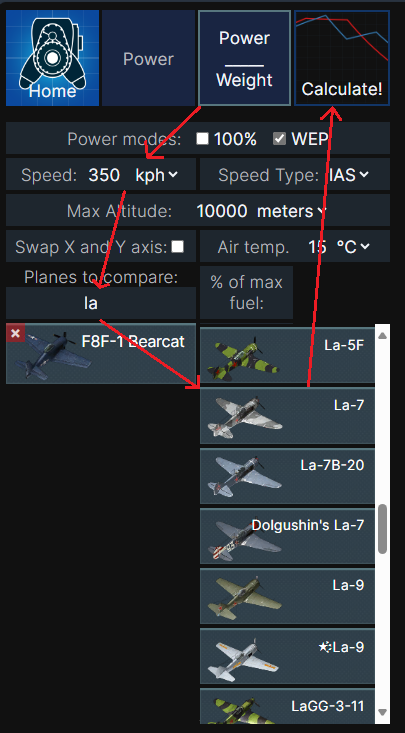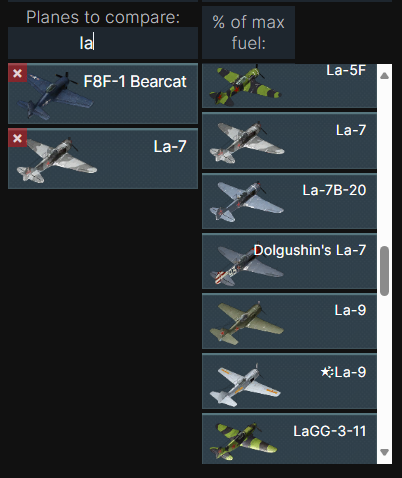Would you use this website when it becomes available?
- Yes
- No
- Yes, but only if jet aircraft are also included
Do you prefer it as a website, or a desktop app (updated manually by downloading)?
I’m making a website for comparing Power-to-Weight ratios of any piston engine aircraft in the game. I am curious how useful it is to the community, so please vote and leave your feedback. I will know whether to put it online first or to first improve it.
The website allows you to see at which altitudes your plane performs best vs planes you struggle fighting with.
1. Here’s how to use it:
Let’s say you’re in a La-7 at 5000m and you encounter F8F-1 at the same altitude. You can’t run because F8F is always faster, and you can never outclimb it. The only choice is a dogfight… but at what altitude?
You learn that by choosing those planes from a dropdown, choosing a speed of dogfighting (usually 300-400kph) and pressing “Calculate!”.
Shown on the user interface

Default values of other settings are fine (30% fuel means min-fuel). A new graph appears with Power-to-Weight ratio of La-7 and F8F-1 across 0-10000m:
La-7 has the biggest advantage from 200m to 1km and from 5.4km up. On the other hand, F8F gains a considerable advantage between 2km and 4km.
Therefore, it’s best for you to force the fight above 5km, if the battle situation allows for that. Alternatively, dogfight while diving to 200-1000m and fight there, but not below that, because F8F-1 starts gaining power near the deck on its 1st supercharger speed.
2. Website features:
1. Graphs of Power-to-Weight ratio. (click for an example)
2. Graphs of engine power. (click for an example)
3. Any piston engine aircraft in WT can be chosen from a WT-looking dropdown. (click for an example)

- Choosing airspeed, altitude, power mode and air temperature because they affect engine power.
- Changing fuel amount because it affects weight.
- Speed in kph, mph or kt, altitude in m or ft, temperature in °C or °F.
- Hiding and showing graph lines of particular planes, by clicking on them in the legend.
- Graphs are downloadable as .png.
3. Why make this website:
To create a comprehensive, objective, automatically updated source of info about WT aircraft performance, with climb-rate and top speed graphs being the end goal.
There are no such sources:
-
In-game statcards are notoriously inaccurate about most things they state, and information is very limited.
-
WT wiki has the same issue but also has subjective opinions about aircraft, which are frequently wrong.
-
Forum datasheets:
Air RB - Game Mechanics Guide
Aircraft Data Sheets - War Thunder - Official Forum
are by far the most comprehensive and close to the truth, good info sources. Unfortunately, sometimes they are outdated because planes aren’t re-tested after updates in flight models. Sometimes, incorrect information is present in them too. They also don’t provide information about Power-to-Weight, optimal altitude ranges for fighting, or ways to easily compare planes, which this website does.
This lack of comprehensive info leads to spreading of misinformation of forums, discords, YouTube etc. which contributes to players not being as good as they could and suffering as a result.
4. When will it be available:
In 2-6 months, depending on the feedback, but it might take longer. Of course, the engine power and weight calculation scripts will be open sourced on GitHub. Upon release I’ll make a Discord server for this project, for anyone interested in it and also for figuring out the problems described in 5. Limitations and future improvement.
I’ll be happy to hear your feedback about this project. Whether it will be useful to you or not, what would you change in it, or whether you’d like to help in developing it after release.
5. Limitations and future improvement:
Things described below won’t be implemented quicky, they could take many many months to figure out.
For the curious
Power to weight ratio isn’t perfect in telling which plane is better in producing excess energy; it doesn’t take into account propeller efficiency. That’s why many US fighters with very good propellers, like P-51s, P-47s and F4Us look a bit worse on the graph than how they perform in game. And planes with inefficient propellers like biplanes, M.B. 157 or La 5, 7, 9, 11 look a bit too good.
To solve this, prop efficiency needs to be calculated to get Thrust-to-Weight - a better metric than Power-to-Weight. However, calculating it based on Datamine files appears to be extremely difficult, because propellers are modelled accurately with many parameters. I’m not aware of anyone in the community who managed to do that, so if you work on it or know someone who does, please let me know!
Even with Thrust-to-Weight ratio you can’t estimate climb rate or top speeds, because it doesn’t take into account airframe aerodynamics at all. Planes with low induced drag are underestimated when you want to estimate climb rate, and ones with low parasite drag are vastly underestimated when you want to estimate top speed.
It’s a big achievement that more people should be aware of. It also models thrust of jet aircraft, so all pieces needed to estimate jet top speed and climb are are there. It needs help in development via contributions on GitHub. It’s a great jet equivalent to my propeller aircraft focused website, and it’s available on
DEFYN discord in
botting.
6. What else is it useful for:
For the curious
You can find which variant of a plane is better (works best if planes are similar). Let’s say you want to check how big of an improvement Yak-3U is compared to Yak-3, and if it’s worth it to get a Yak-3 (VK-107), since you only care about performance:
Well, Yak-3U has much better hp/kg vs Yak-3 so it’s clearly a much better plane, since the airframe and therefore manoeuvrability is similar. Yak-3 (VK-107) is only better in a 3-5 km range, while Yak-3U offers better performance everywhere else. So, if you only care about performance, then Yak-3 (VK-107) is not worth it, since currently both are at 5.7 Br.
7. How it was made:
For the curious
It is written in Python, and it reads files from flightmodels and flightmodels/fm directory from
gszabi99/War-Thunder-Datamine (github.com). Parameters from the files are used to calculate engine power and a graph is made. I validated it by comparing calculated power to actual power logged while climbing in test-flight. I did it with around 60 planes using
WTRTI (mesofthorny.github.io), and on almost all planes the model is within ± 1% margin of error. Only in Tu-1 and P-63s error increases to ± 5%, but there might be more errors I didn’t notice.
Overall the whole engine power calculation is surprisingly complex. There are a lot of parameters in FM files that affect:
- critical altitudes
- how change in RPM and switching to WEP changes critical altitudes and power output below them,
- curvature below and above critical altitude
- the effect of speed on critical altitudes (RAM effect)
- and much more
It’s weird how simply all jet engines are modelled compared to piston engines.





